英文诗歌鉴赏方法
a red red rose诗歌鉴赏
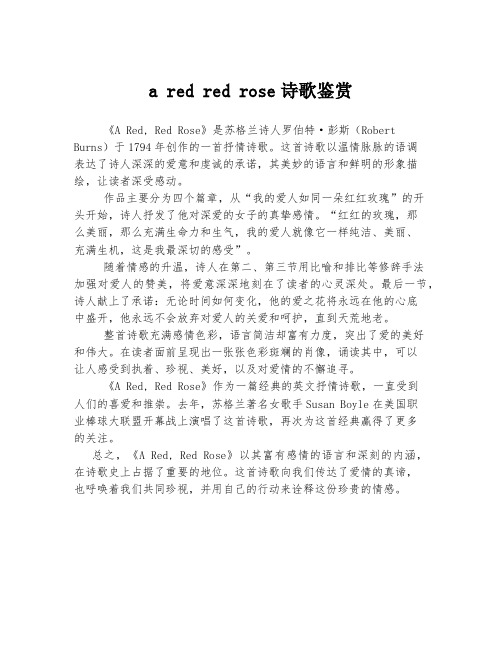
a red red rose诗歌鉴赏
《A Red, Red Rose》是苏格兰诗人罗伯特·彭斯(Robert Burns)于1794年创作的一首抒情诗歌。
这首诗歌以温情脉脉的语调
表达了诗人深深的爱意和虔诚的承诺,其美妙的语言和鲜明的形象描绘,让读者深受感动。
作品主要分为四个篇章,从“我的爱人如同一朵红红玫瑰”的开
头开始,诗人抒发了他对深爱的女子的真挚感情。
“红红的玫瑰,那
么美丽,那么充满生命力和生气,我的爱人就像它一样纯洁、美丽、
充满生机,这是我最深切的感受”。
随着情感的升温,诗人在第二、第三节用比喻和排比等修辞手法
加强对爱人的赞美,将爱意深深地刻在了读者的心灵深处。
最后一节,诗人献上了承诺:无论时间如何变化,他的爱之花将永远在他的心底
中盛开,他永远不会放弃对爱人的关爱和呵护,直到天荒地老。
整首诗歌充满感情色彩,语言简洁却富有力度,突出了爱的美好
和伟大。
在读者面前呈现出一张张色彩斑斓的肖像,诵读其中,可以
让人感受到执着、珍视、美好,以及对爱情的不懈追寻。
《A Red, Red Rose》作为一篇经典的英文抒情诗歌,一直受到
人们的喜爱和推崇。
去年,苏格兰著名女歌手Susan Boyle在美国职
业棒球大联盟开幕战上演唱了这首诗歌,再次为这首经典赢得了更多
的关注。
总之,《A Red, Red Rose》以其富有感情的语言和深刻的内涵,在诗歌史上占据了重要的地位。
这首诗歌向我们传达了爱情的真谛,
也呼唤着我们共同珍视,并用自己的行动来诠释这份珍贵的情感。
从英诗的美学角度鉴赏《london》
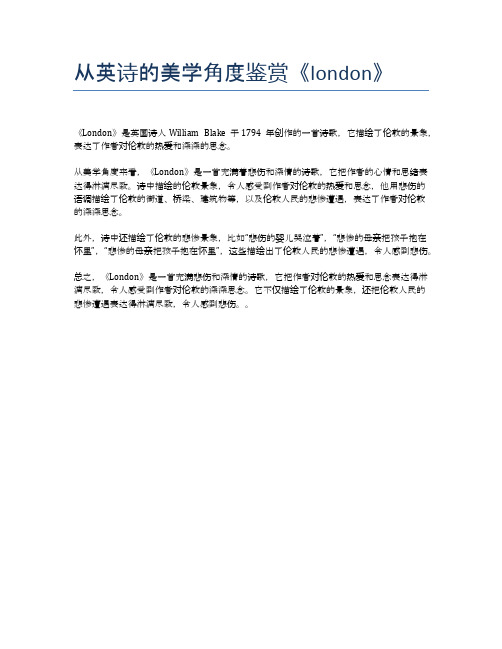
从英诗的美学角度鉴赏《london》
《London》是英国诗人William Blake于1794年创作的一首诗歌,它描绘了伦敦的景象,表达了作者对伦敦的热爱和深深的思念。
从美学角度来看,《London》是一首充满着悲伤和深情的诗歌,它把作者的心情和思绪表达得淋漓尽致。
诗中描绘的伦敦景象,令人感受到作者对伦敦的热爱和思念,他用悲伤的语调描绘了伦敦的街道、桥梁、建筑物等,以及伦敦人民的悲惨遭遇,表达了作者对伦敦的深深思念。
此外,诗中还描绘了伦敦的悲惨景象,比如“悲伤的婴儿哭泣着”,“悲惨的母亲把孩子抱在怀里”,“悲惨的母亲把孩子抱在怀里”,这些描绘出了伦敦人民的悲惨遭遇,令人感到悲伤。
总之,《London》是一首充满悲伤和深情的诗歌,它把作者对伦敦的热爱和思念表达得淋漓尽致,令人感受到作者对伦敦的深深思念。
它不仅描绘了伦敦的景象,还把伦敦人民的
悲惨遭遇表达得淋漓尽致,令人感到悲伤。
英语诗歌赏析技巧
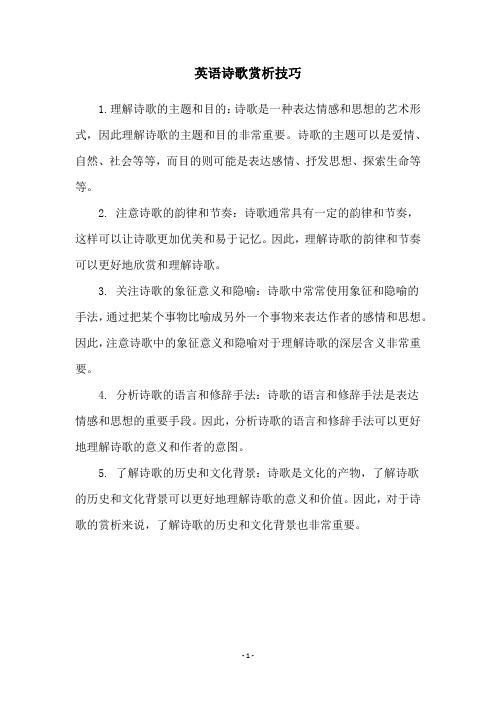
英语诗歌赏析技巧
1.理解诗歌的主题和目的:诗歌是一种表达情感和思想的艺术形式,因此理解诗歌的主题和目的非常重要。
诗歌的主题可以是爱情、自然、社会等等,而目的则可能是表达感情、抒发思想、探索生命等等。
2. 注意诗歌的韵律和节奏:诗歌通常具有一定的韵律和节奏,
这样可以让诗歌更加优美和易于记忆。
因此,理解诗歌的韵律和节奏可以更好地欣赏和理解诗歌。
3. 关注诗歌的象征意义和隐喻:诗歌中常常使用象征和隐喻的
手法,通过把某个事物比喻成另外一个事物来表达作者的感情和思想。
因此,注意诗歌中的象征意义和隐喻对于理解诗歌的深层含义非常重要。
4. 分析诗歌的语言和修辞手法:诗歌的语言和修辞手法是表达
情感和思想的重要手段。
因此,分析诗歌的语言和修辞手法可以更好地理解诗歌的意义和作者的意图。
5. 了解诗歌的历史和文化背景:诗歌是文化的产物,了解诗歌
的历史和文化背景可以更好地理解诗歌的意义和价值。
因此,对于诗歌的赏析来说,了解诗歌的历史和文化背景也非常重要。
- 1 -。
英语诗歌翻译鉴赏剖析

春望
国破山河在,城春草木深, 感时花溅泪,恨别鸟惊心。 烽火连三月,家书抵万金; 白头搔更短,浑欲不胜簪 wet
with dewy tears
(C.C. Kwock and Vincent McHugh 译)
(2) 意义上的忠实 (从诗的意象上来看)
诗歌翻译的忠实性旨在重现原作的艺术美,不仅传达了 原作的意义,更在译作中展现出原作所要表达的意境。有例如 下:
中国著名诗歌翻译家许渊冲教授就 曾经翻译过多本中国古体诗。《唐诗300 首》是其最杰出的作品。 古铮昆也是通过翻译《毛泽东诗歌 选集》将中国诗歌介绍给外国读者。 还有包括Arthur Waley, Herbert Giles在内的国外翻译家们也致力于中西 方诗歌的交流。
诗歌翻译的几项原则
• 1.忠实性原则
此外,根据诗行的长短、即音步的多少,可分为8种音步: 一音步(monometer),二音步(dimeter),三音步 (trimeter),四音步(tetrameter),五音步 (pentameter),六音步(hexameter), 七音步 (heptameter)和八音步(octameter)。 如果一首诗用了抑扬格,每行诗句一个音步,就称为一步抑扬 格(lambic monometer),如课本312页的例1.如果一首诗用 了扬抑格,每行诗句两个音步,就称为两步扬抑格。如课本313 页的例2. 汉语诗词的格律主要限于古体诗词,有五言诗、七言诗和各 种词牌,如《水调歌头》、《清平乐》等。
(1) 诗歌翻译的第一步在于“达意”。 其重点在于“字字传神”
以下是一首唐诗名字的三种不同译本,通过对这些译本标题 翻译的比较来揭示意美的实现方式。 《枫桥夜泊》英译为: 1)Mooring by Maple Bridge at Night 2) Anchored at Night near Maple Bridge 原文标题可分成三个点:枫桥、夜、泊。分别是地点, 时间和行为。在翻译成英语时,根据英语读者的认知习惯, 时间一般放在地点后面。三个译文都将“枫桥”译成 “Maple Bridge”。而“泊”一词的译法却大相径庭。 “moor”一般用来指小船停泊靠岸,而“anchor”则是指 大轮船抛锚靠岸。“mooring”是进行时,“anchored” 是完成时,因而前者是动态描写,仿佛诗人的小船正缓缓向 岸边驶来,后者是静态描写,远不及“mooring”形象逼真, 更能传达原诗的意义。
英文诗歌鉴赏-The road not taken
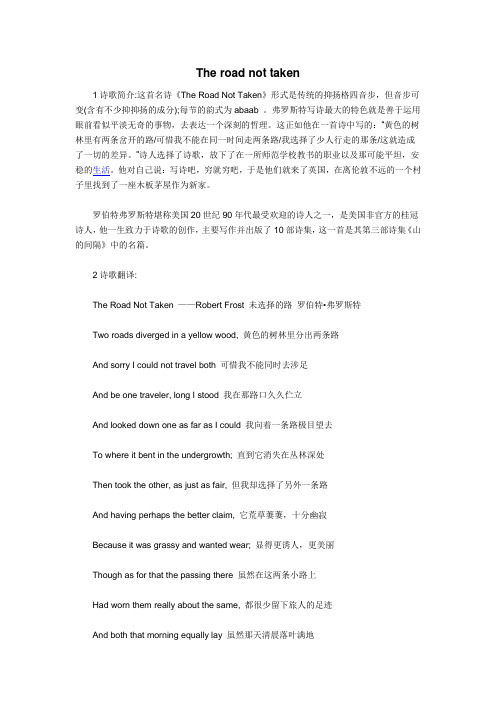
The road not taken1诗歌简介:这首名诗《The Road Not Taken》形式是传统的抑扬格四音步,但音步可变(含有不少抑抑扬的成分);每节的韵式为abaab 。
弗罗斯特写诗最大的特色就是善于运用眼前看似平淡无奇的事物,去表达一个深刻的哲理。
这正如他在一首诗中写的:“黄色的树林里有两条岔开的路/可惜我不能在同一时间走两条路/我选择了少人行走的那条/这就造成了一切的差异。
”诗人选择了诗歌,放下了在一所师范学校教书的职业以及那可能平坦,安稳的生活。
他对自己说:写诗吧,穷就穷吧,于是他们就来了英国,在离伦敦不远的一个村子里找到了一座木板茅屋作为新家。
罗伯特弗罗斯特堪称美国20世纪90年代最受欢迎的诗人之一,是美国非官方的桂冠诗人,他一生致力于诗歌的创作,主要写作并出版了10部诗集,这一首是其第三部诗集《山的间隔》中的名篇。
2诗歌翻译:The Road Not Taken ——Robert Frost 未选择的路罗伯特•弗罗斯特Two roads diverged in a yellow wood, 黄色的树林里分出两条路And sorry I could not travel both 可惜我不能同时去涉足And be one traveler, long I stood 我在那路口久久伫立And looked down one as far as I could 我向着一条路极目望去To where it bent in the undergrowth; 直到它消失在丛林深处Then took the other, as just as fair, 但我却选择了另外一条路And having perhaps the better claim, 它荒草萋萋,十分幽寂Because it was grassy and wanted wear; 显得更诱人,更美丽Though as for that the passing there 虽然在这两条小路上Had worn them really about the same, 都很少留下旅人的足迹And both that morning equally lay 虽然那天清晨落叶满地In leaves no step had trodden black. 两条路都未经脚印污染Oh, I kept the first for another day! 呵,留下一条路等改日再见Yet knowing how way leads on to way, 但我知道路径延绵无尽头I doubted if I should ever come back. 恐怕我难以再回返I shall be telling this with a sigh 也许多少年后在某一个地方Somewhere ages and ages hence: 我将轻声叹息把往事回顾Two roads diverged in a wood,and I, 一片森林里分出两条路I took the one less traveled by, 而我却选择了人迹更少的一条And that has made all the difference.从此决定了我一生的道路3诗歌赏析:(1)诗歌特点:全诗共4节,可分两层:1—3节为第一层,在树林里,“我”面临着两条路,而经过思考决定选择了一条人迹罕至的路。
英国诗歌鉴赏

二﹑ Rhyme
英诗的音乐性还表现在音韵上。 英诗的音乐性还表现在音韵上。常见的音韵形 式可以分为两大类: 式可以分为两大类: 1. End rhymes(尾韵 :行尾押韵单词最后的重读 尾韵): 尾韵 元音及其后面的辅音在读音上相同, 元音及其后面的辅音在读音上相同,而元音前 面的辅音则不能相同。 面的辅音则不能相同。这种韵又被称为全韵 (perfect rhyme)。 )。 根据音节的数量,可分为单音节尾韵(single 根据音节的数量,可分为单音节尾韵 rhyme)、双音节尾韵 、双音节尾韵(double rhyme)和三重音 和三重音 节尾韵(triple rhyme)。 节尾韵 。 •
多种步格在一首诗歌中的同时运用
Woman wants monogamy; Man delights in novelty. Love is woman’s moon and sun. Man has other forms of fun. Woman lives but in her lord. Count to ten, and man is bored. With this the gist and sum of it. What earthly good can come of it? (Dorothy Parker: General Review of the Sex Situachaic: a stressed followed by an unstressed syllable. (“trochee”)
Twinkle, twinkle, little star, How I wonder what you are. Up above the world so high, Like a diamond in the sky. (Jane Taylor, “Star”)
英文诗歌赏析

英文诗歌赏析诗以高度凝结的语言表达着人们的喜怒哀乐,用其特有的节奏与方式影响着人们的精神世界。
然而,诗歌由于用词典雅、句法精炼、形式别致以及意象丰富等缘故,让很多人不知如何去赏析。
从文体分析和主题分析两大方面,对诗歌进行解释和赏析,使读者从诗歌的语言特点,语言风格的角度来欣赏诗歌。
诗歌主题分析文体分析一、引言诗歌是一种精美的艺术,它有其独特的语言特点和表达方式:诗歌语言最精炼,语汇最丰富,表达形式最精美,语言的色调最细腻。
所以我们在欣赏诗歌时,不但要运用理解诗歌的基本知识去分析,还要透过语言本身去揭示诗歌中所包含的主题。
本文就从文体分析法和主题分析法两部分去理解其美学意义以及其所产生的社会意义与价值。
二、文体分析法文体分析法既是运用语言学的理论对文学作品进行分析,多关注语言体系和语言特点。
如果从语言学和文体学的角度来研究诗歌的特点,我们一定要学会从诗的韵脚、诗的音步,词音象征法几大方面来分析诗歌,而这些也是分析诗歌所必须掌握的基本知识。
诗的音步。
诗歌是具有音乐性的语言。
音乐作品的最大特点之一是音符的流动是有节奏的。
所谓节奏就是强拍和弱拍按一定的形式配合起来,有规律地反复出来,诗歌的两个主要特点就是韵脚和音步,有了他们,诗歌读起来才悦耳,才能形成节奏感。
而音步是由重读音节和非重读音节构成的诗的分析单位。
一般情况下分为如下几种:1.抑扬格。
如果一个音步中有两个音节,前者为轻,后者为重,则这种音步叫抑扬格音步,其专业术语是(iamb, iambic.)。
轻读是“抑”,重读是“扬”,一轻一重,故称抑扬格。
英语中有大量的单词,其发音都是一轻一重,如adore, excite, above, around, appear, besides, attack, supply, believe, return等,所以用英语写诗,用抑扬格就很便利。
也就是说,抑扬格很符合英语的发音规律。
因此,在英文诗歌中用得最多的便是抑扬格,百分之九十的英文诗都是用抑扬格写成的。
短篇英文诗歌鉴赏

短篇英文诗歌鉴赏(原创实用版)目录一、短篇英文诗歌的概述二、短篇英文诗歌的特点三、短篇英文诗歌的鉴赏方法四、短篇英文诗歌的价值正文一、短篇英文诗歌的概述短篇英文诗歌,顾名思义,是指篇幅较短的英文诗歌。
相较于长篇诗歌,短篇诗歌更注重语言的精炼和情感的瞬间表达。
短篇英文诗歌起源于英国文学史的各个时期,如古英语时期、中世纪时期、文艺复兴时期等,并一直延续至今。
二、短篇英文诗歌的特点1.篇幅简短:短篇英文诗歌最显著的特点就是篇幅简短,通常在一百行以内。
这使得诗人需要在有限的篇幅内,高度浓缩情感和思想。
2.语言精炼:短篇英文诗歌的语言要求非常高,诗人需要用精炼的词汇表达丰富的内涵。
这使得短篇诗歌具有很高的艺术价值。
3.情感瞬间:短篇英文诗歌注重情感的瞬间表达,往往捕捉一种瞬间的感悟或情感,如爱情、友谊、哲理等。
三、短篇英文诗歌的鉴赏方法1.把握主题:鉴赏短篇英文诗歌首先要把握诗歌的主题。
通过阅读诗歌,理解诗人想要表达的情感和思想。
2.理解象征:诗歌中常常出现象征手法,通过理解和分析象征,可以更好地把握诗歌的内涵。
3.欣赏语言:短篇英文诗歌的语言具有很高的艺术价值,欣赏诗歌的语言美,可以更好地领略诗歌的魅力。
4.体会节奏:诗歌的节奏和韵律是诗歌美感的重要组成部分。
通过体会诗歌的节奏和韵律,可以更好地欣赏诗歌。
四、短篇英文诗歌的价值1.文学价值:短篇英文诗歌作为英文文学的一种重要形式,具有很高的文学价值。
它丰富了英文文学的种类,为读者提供了多样化的审美体验。
2.艺术价值:短篇英文诗歌的语言精炼、情感真挚、寓意深刻,具有很高的艺术价值。
3.教育价值:通过阅读和鉴赏短篇英文诗歌,可以提高读者的文学素养、审美能力,培养读者的情感共鸣和思考能力。
总之,短篇英文诗歌作为英文文学的一种重要形式,既有独特的特点,也具有很高的价值。
英文诗歌鉴赏方法与技巧
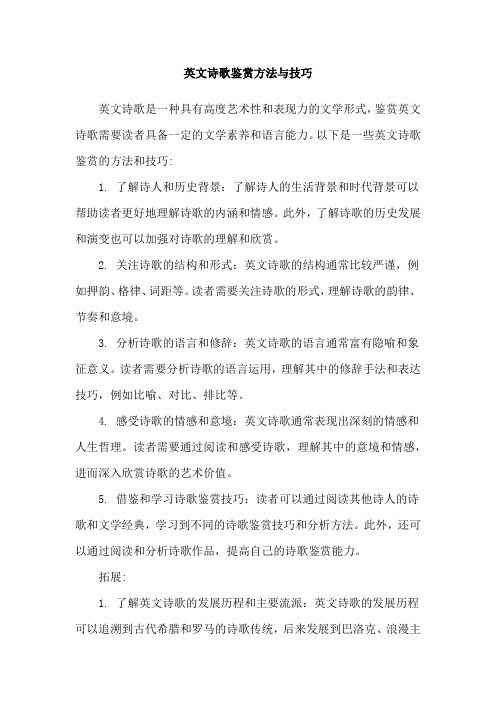
英文诗歌鉴赏方法与技巧英文诗歌是一种具有高度艺术性和表现力的文学形式,鉴赏英文诗歌需要读者具备一定的文学素养和语言能力。
以下是一些英文诗歌鉴赏的方法和技巧:1. 了解诗人和历史背景:了解诗人的生活背景和时代背景可以帮助读者更好地理解诗歌的内涵和情感。
此外,了解诗歌的历史发展和演变也可以加强对诗歌的理解和欣赏。
2. 关注诗歌的结构和形式:英文诗歌的结构通常比较严谨,例如押韵、格律、词距等。
读者需要关注诗歌的形式,理解诗歌的韵律、节奏和意境。
3. 分析诗歌的语言和修辞:英文诗歌的语言通常富有隐喻和象征意义。
读者需要分析诗歌的语言运用,理解其中的修辞手法和表达技巧,例如比喻、对比、排比等。
4. 感受诗歌的情感和意境:英文诗歌通常表现出深刻的情感和人生哲理。
读者需要通过阅读和感受诗歌,理解其中的意境和情感,进而深入欣赏诗歌的艺术价值。
5. 借鉴和学习诗歌鉴赏技巧:读者可以通过阅读其他诗人的诗歌和文学经典,学习到不同的诗歌鉴赏技巧和分析方法。
此外,还可以通过阅读和分析诗歌作品,提高自己的诗歌鉴赏能力。
拓展:1. 了解英文诗歌的发展历程和主要流派:英文诗歌的发展历程可以追溯到古代希腊和罗马的诗歌传统,后来发展到巴洛克、浪漫主义和现代诗歌等主要流派。
了解这些历史背景和流派可以帮助读者更好地理解英文诗歌的文化背景和艺术特色。
2. 关注英文诗歌的文学价值和意义:英文诗歌是一种具有高度文学价值和艺术价值的诗歌形式。
读者可以通过阅读和研究英文诗歌,了解和感受诗歌在人类文化史上的重要性和影响力。
3. 欣赏英文诗歌的韵律和美感:英文诗歌的韵律和美感是其独特的艺术特色之一。
读者可以通过练习朗诵和欣赏英文诗歌,感受到英文诗歌的韵律和美感,进而更好地理解和欣赏英文诗歌。
有关英文诗歌范文(精选4篇)
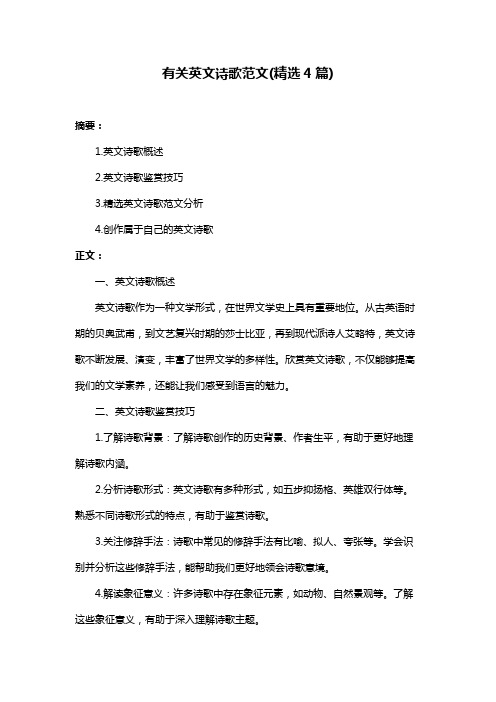
有关英文诗歌范文(精选4篇)摘要:1.英文诗歌概述2.英文诗歌鉴赏技巧3.精选英文诗歌范文分析4.创作属于自己的英文诗歌正文:一、英文诗歌概述英文诗歌作为一种文学形式,在世界文学史上具有重要地位。
从古英语时期的贝奥武甫,到文艺复兴时期的莎士比亚,再到现代派诗人艾略特,英文诗歌不断发展、演变,丰富了世界文学的多样性。
欣赏英文诗歌,不仅能够提高我们的文学素养,还能让我们感受到语言的魅力。
二、英文诗歌鉴赏技巧1.了解诗歌背景:了解诗歌创作的历史背景、作者生平,有助于更好地理解诗歌内涵。
2.分析诗歌形式:英文诗歌有多种形式,如五步抑扬格、英雄双行体等。
熟悉不同诗歌形式的特点,有助于鉴赏诗歌。
3.关注修辞手法:诗歌中常见的修辞手法有比喻、拟人、夸张等。
学会识别并分析这些修辞手法,能帮助我们更好地领会诗歌意境。
4.解读象征意义:许多诗歌中存在象征元素,如动物、自然景观等。
了解这些象征意义,有助于深入理解诗歌主题。
三、精选英文诗歌范文分析1.威廉·布莱克《Tyger Tyger》这首诗歌以独特的象征手法,表达了对人性中恶与善的探讨。
通过描绘老虎这一形象,布莱克展示了恶的威力,同时呼吁人们关注心灵的救赎。
2.约翰·济慈《夜莺颂》这首诗歌以夜莺为主题,抒发了诗人对生命的热爱和对美好事物的向往。
诗歌语言优美,情感真挚,展现了济慈作为浪漫主义诗人的独特魅力。
3.托马斯·特朗斯特罗姆《地铁车站》这首诗歌以地铁车站为背景,描绘了一个城市人的生活状态。
通过对地铁站景象的细腻描绘,反映了现代社会的冷漠与疏离。
4.罗伯特·弗罗斯特《未选择的路》这首诗歌以两条道路的选择为象征,表达了人生道路选择的困惑与思考。
诗歌意境深远,引人深思。
四、创作属于自己的英文诗歌1.学习优秀诗歌作品,积累创作灵感。
2.多进行生活观察,发现身边的美与感动。
3.尝试运用修辞手法,丰富诗歌表现力。
4.反复修改,力求诗歌作品完美呈现。
英文诗歌鉴赏
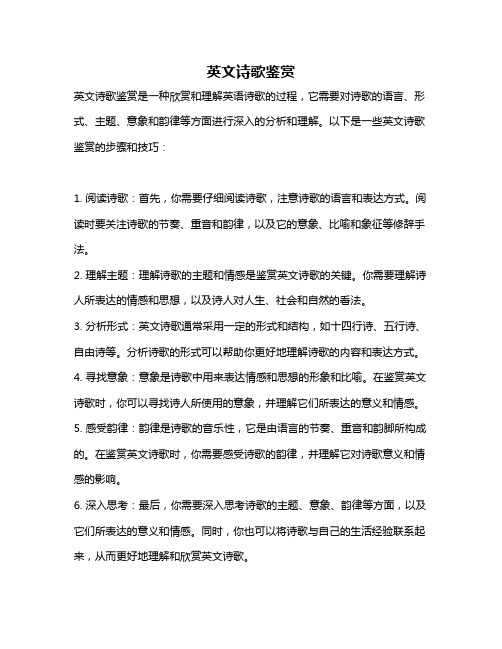
英文诗歌鉴赏
英文诗歌鉴赏是一种欣赏和理解英语诗歌的过程,它需要对诗歌的语言、形式、主题、意象和韵律等方面进行深入的分析和理解。
以下是一些英文诗歌鉴赏的步骤和技巧:
1. 阅读诗歌:首先,你需要仔细阅读诗歌,注意诗歌的语言和表达方式。
阅读时要关注诗歌的节奏、重音和韵律,以及它的意象、比喻和象征等修辞手法。
2. 理解主题:理解诗歌的主题和情感是鉴赏英文诗歌的关键。
你需要理解诗人所表达的情感和思想,以及诗人对人生、社会和自然的看法。
3. 分析形式:英文诗歌通常采用一定的形式和结构,如十四行诗、五行诗、自由诗等。
分析诗歌的形式可以帮助你更好地理解诗歌的内容和表达方式。
4. 寻找意象:意象是诗歌中用来表达情感和思想的形象和比喻。
在鉴赏英文诗歌时,你可以寻找诗人所使用的意象,并理解它们所表达的意义和情感。
5. 感受韵律:韵律是诗歌的音乐性,它是由语言的节奏、重音和韵脚所构成的。
在鉴赏英文诗歌时,你需要感受诗歌的韵律,并理解它对诗歌意义和情感的影响。
6. 深入思考:最后,你需要深入思考诗歌的主题、意象、韵律等方面,以及它们所表达的意义和情感。
同时,你也可以将诗歌与自己的生活经验联系起来,从而更好地理解和欣赏英文诗歌。
总之,英文诗歌鉴赏需要一定的技巧和经验,但只要你多读、多思考,就能够提高自己的鉴赏能力,更好地欣赏和理解英文诗歌的美妙之处。
英语诗歌赏析技巧
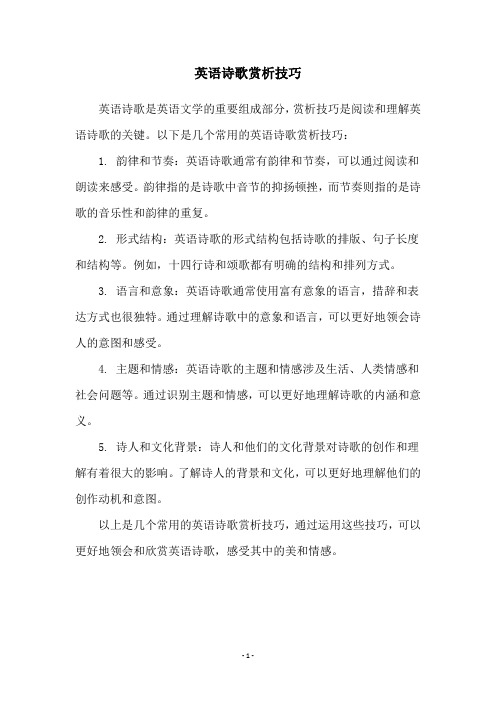
英语诗歌赏析技巧
英语诗歌是英语文学的重要组成部分,赏析技巧是阅读和理解英语诗歌的关键。
以下是几个常用的英语诗歌赏析技巧:
1. 韵律和节奏:英语诗歌通常有韵律和节奏,可以通过阅读和朗读来感受。
韵律指的是诗歌中音节的抑扬顿挫,而节奏则指的是诗歌的音乐性和韵律的重复。
2. 形式结构:英语诗歌的形式结构包括诗歌的排版、句子长度和结构等。
例如,十四行诗和颂歌都有明确的结构和排列方式。
3. 语言和意象:英语诗歌通常使用富有意象的语言,措辞和表达方式也很独特。
通过理解诗歌中的意象和语言,可以更好地领会诗人的意图和感受。
4. 主题和情感:英语诗歌的主题和情感涉及生活、人类情感和社会问题等。
通过识别主题和情感,可以更好地理解诗歌的内涵和意义。
5. 诗人和文化背景:诗人和他们的文化背景对诗歌的创作和理解有着很大的影响。
了解诗人的背景和文化,可以更好地理解他们的创作动机和意图。
以上是几个常用的英语诗歌赏析技巧,通过运用这些技巧,可以更好地领会和欣赏英语诗歌,感受其中的美和情感。
- 1 -。
短篇英文诗歌鉴赏
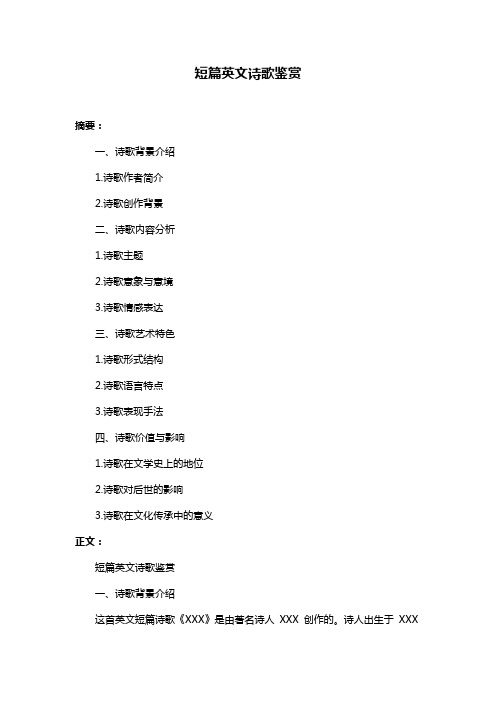
短篇英文诗歌鉴赏摘要:一、诗歌背景介绍1.诗歌作者简介2.诗歌创作背景二、诗歌内容分析1.诗歌主题2.诗歌意象与意境3.诗歌情感表达三、诗歌艺术特色1.诗歌形式结构2.诗歌语言特点3.诗歌表现手法四、诗歌价值与影响1.诗歌在文学史上的地位2.诗歌对后世的影响3.诗歌在文化传承中的意义正文:短篇英文诗歌鉴赏一、诗歌背景介绍这首英文短篇诗歌《XXX》是由著名诗人XXX 创作的。
诗人出生于XXX年,是XXX 时期的代表人物,他的创作以XXX 为主题,强调XXX。
该诗歌创作于XXX 年,当时诗人正处于XXX 的生活阶段,面临了XXX 的困境,因此创作了这首诗歌来表达他的思考与感悟。
二、诗歌内容分析1.诗歌主题《XXX》这首诗歌的主题是XXX。
诗人通过描绘XXX 的景象,抒发了自己对XXX 的思考与感悟。
2.诗歌意象与意境在诗歌中,诗人运用了丰富的意象和意境,如XXX。
这些意象生动地展现了诗歌的主题,营造出了一种XXX 的意境。
3.诗歌情感表达诗人通过诗歌表达了自己对XXX 的XXX 情感,如XXX。
这些情感表达使诗歌具有了强烈的感染力,让人产生共鸣。
三、诗歌艺术特色1.诗歌形式结构这首诗歌采用了XXX 的形式结构,如XXX。
这种结构使诗歌具有了优美的韵律和和谐的节奏。
2.诗歌语言特点诗人在创作中运用了丰富的修辞手法,如XXX。
这些手法使诗歌语言具有了生动的形象性和强烈的表现力。
3.诗歌表现手法诗人采用了多种表现手法来展现诗歌的主题,如XXX。
这些手法使诗歌具有了丰富的内涵和深刻的意义。
四、诗歌价值与影响1.诗歌在文学史上的地位《XXX》这首诗歌在文学史上具有重要的地位。
它是XXX 时期诗歌创作的杰出代表,对后世产生了深远的影响。
2.诗歌对后世的影响这首诗歌对后世诗歌创作产生了很大的影响。
许多后世诗人都在自己的作品中表达了对这首诗歌的敬意和借鉴。
3.诗歌在文化传承中的意义《XXX》这首诗歌在文化传承中具有重要的意义。
赏析英文诗歌的四种方法

赏析英文诗歌的四种方法赏析英文诗歌的四种方法赏析英文诗歌的四种方法——对比分析、关注音步和韵律、还原情景、分析用词用句,并以北师大版高中英语教材和其他若干英文诗歌为例,演示如何赏析不同类别诗歌的节奏和韵律、表情和达意、用词和用句,以及如何通过诗歌的赏析来提高学生的审美能力和英语学科核心素养。
1.对比分析赏析英文诗歌“对比分析”能够有效地调动起学生原有的母语诗歌赏析经验,助力学生理解英文诗歌的基本意义。
众所周知,中英文诗歌在性质上有着众多的共性,例如,中英文诗歌都有音韵节奏美的特点,都使用意象意境来抒发感情,都运用明喻隐喻、夸张拟人等修辞手法。
但与此同时,中英文诗歌的表达形式、意象寓意、文化内涵却又大相径庭,同样的月亮却有着不同的意蕴。
中国学生在小学、初中阶段的汉语诗歌学习过程中,已经积累起了相当的诗歌赏析知识和经验。
如果教师能够尽可能地利用学生已具有的中文诗歌知识对照分析、相互比较,不仅对英文诗歌的理解和赏析有益,而且也有助于学生认识和了解中英文化。
北师大版《英语》选修Module 6 Unit 18 Lesson 3 “Poetry”推荐使用了这一方法。
教材选用了学生最熟悉的中国诗人李白的《静夜思》英译版A Tranquil Night和英文圣诞诗歌Twas the Night Before Christmas。
A Tranquil Night (by Li Bai)Before my bed a frost of light,Is it hoarfrost upon the ground?Eyes raised,I see the moon so bright;Head bent,in homesickness I am drowned.教学方法第一步:教师将常用的英文诗歌赏析表达术语给学生,如:rhyme(韵脚)、rhythm(节奏)、image(意象)、simile(明喻)、metaphor(暗喻)、exaggeration(夸张)等。
英文诗歌鉴赏
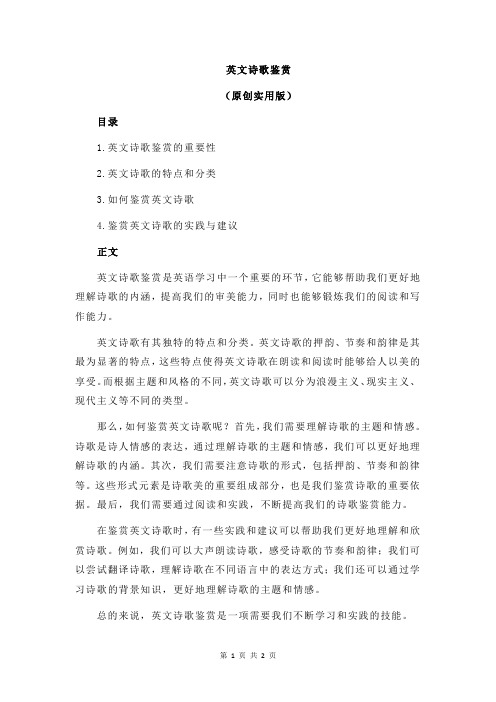
英文诗歌鉴赏
(原创实用版)
目录
1.英文诗歌鉴赏的重要性
2.英文诗歌的特点和分类
3.如何鉴赏英文诗歌
4.鉴赏英文诗歌的实践与建议
正文
英文诗歌鉴赏是英语学习中一个重要的环节,它能够帮助我们更好地理解诗歌的内涵,提高我们的审美能力,同时也能够锻炼我们的阅读和写作能力。
英文诗歌有其独特的特点和分类。
英文诗歌的押韵、节奏和韵律是其最为显著的特点,这些特点使得英文诗歌在朗读和阅读时能够给人以美的享受。
而根据主题和风格的不同,英文诗歌可以分为浪漫主义、现实主义、现代主义等不同的类型。
那么,如何鉴赏英文诗歌呢?首先,我们需要理解诗歌的主题和情感。
诗歌是诗人情感的表达,通过理解诗歌的主题和情感,我们可以更好地理解诗歌的内涵。
其次,我们需要注意诗歌的形式,包括押韵、节奏和韵律等。
这些形式元素是诗歌美的重要组成部分,也是我们鉴赏诗歌的重要依据。
最后,我们需要通过阅读和实践,不断提高我们的诗歌鉴赏能力。
在鉴赏英文诗歌时,有一些实践和建议可以帮助我们更好地理解和欣赏诗歌。
例如,我们可以大声朗读诗歌,感受诗歌的节奏和韵律;我们可以尝试翻译诗歌,理解诗歌在不同语言中的表达方式;我们还可以通过学习诗歌的背景知识,更好地理解诗歌的主题和情感。
总的来说,英文诗歌鉴赏是一项需要我们不断学习和实践的技能。
浅析英文诗歌的赏析

文 学批 评 的最 终 目的是 为 了 能把 文 学 作 品 作 为 艺 术 品 来 加 以解 读 和 鉴赏 ,而 评 论家 们 最 关注 的却 是如 何 解读 作者 在其 作 品 中所 反 映出 的个 人信 息 以及 这 些信 息在 读 者 中所产 生 的社 会意义和价值 。本文试从托马斯・ 格雷的 《 乡村 墓园挽歌》为 例 ,利用 主 题分 析法 来 诠释 这 首不 朽诗 篇 。 1背 景 知识 。这 部 作 品的 时代 背景 是 1世 纪 中叶 的英 国。 . 8 当时的英国正如火如荼地经历着工业革命 。一方面,工业革命 给 工业 化 带来 了无 限生 机 ;另 一方 面 ,它 却给 农 民带 来 了无尽 的 苦难 。在 资本 家捕 获 了商 机不 断赚 取 利润 的同 时, 宁静 的 田 园 风光 和农 民的 自给 自足 的 安宁 生 活 已不 复存 在 。失去 土地 的 农 民要 么去 城里 成 为廉 价 劳 动力 ,要 么 困 守在 农村 过着 食 不果 腹、衣不蔽体的生活。正是此情此景使作者触景生情 ,创作 出 了这篇堪称经典的 《 乡村墓园挽歌》。 2 词和 修 辞法 的使 用对 主 题 的烘 托 。第一 节至 第 四节 描 . 写的是黄 昏中宁静的乡村景象,充分烘托出乡村的宁静对于农 民来说 是何 等 的重 要 。塔 楼 上那 只 忧郁 的猫 头鹰 在 对着 月光 抱 怨 是拟 人 的手 法 ,用 以暗 示 l世 纪 英 国 田园式 的农 村生 活 即将 8 被 工 业化 吞 噬 ,也 表达 了诗人 对此 无 奈伤 感 的情 怀 。第 十二 至 十 九 节 中诗 人运 用对 比的修 辞 方法 一 方面 充 分地 表达 了对 农 民 疾苦的同情怜悯,另一方面强烈地讽刺 了权贵们尔虞我诈、贪 婪 无情 、虚伪 残 忍 的丑陋 嘴脸 。 3 诗人 的 自由联想 对 主题 的 渲染 。在 第六 、七节 是诗 人想 . 象长眠地下的农夫生前的生活。几句诗句却能勾勒出农夫生前 虽然 物 质 匮乏 但却 不 能不 让 人艳 羡 的 田园生 活 :家 庭 的温馨 、 收获 的快 乐 以及 生 机盎 然 的 田园风 光 。然 而 ,温 馨 的场 景在 残 酷 的现 实面 前变 得 不堪 一 击 。通过 这 些 诗句 ,诗 人流 露 出对 工 业 前 的乡 村 的 留恋 和 对残 酷 的现 实 生活 的不满 。 4 现实意义 。通 过诗歌诗人把 自己对社会严重的贫富分 . 化 、弱 肉强食 、 资本 家对 下层 劳动 人 民无 情的 剥 削等社 会现 象 的不满表现得淋漓尽致。同时,他对劳苦大众的同情和怜悯、 对平静的大 自然和农村传统生活方式遭到破坏的惋惜和哀叹也 体现 在字 里 行 间。
英文诗歌鉴赏与赏析:面向文学爱好者和英语专业学生

英文诗歌鉴赏与赏析:面向文学爱好者和英语
专业学生
CREATE TOGETHER
DOCS
01
英文诗歌的起源与发展历程
英文诗歌的起源及其背景
文艺复兴时期的英文诗歌
• 文艺复兴时期,如威廉·莎士比亚的莎士比亚十四行诗
• 新古典主义,如亚历山大·蒲柏的夺发记
英文诗歌的起源可追溯到公元5世纪
• 后现代主义,如唐·希尔和安·毕晓普的诗歌
⌛️
英文诗歌在现代社会的影响与地位
• 文学研究的的重要组成部分
• 文化交流与理解的桥梁
02
英文诗歌的主要类型与形式
英诗的主要类型及其特点
古典诗歌形式
• 抒情诗,如莎士比亚十四行诗
• 叙事诗,如贝奥武夫
现代诗歌形式
• 自由诗,如哈特·克兰的风暴
• 音步诗,如庞德的地铁车站
• 古英语诗歌,如贝奥武夫和卡德蒙的诗歌
• 受古日耳曼语和古英语影响
中世纪英文诗歌的发展
• 宗教诗歌,如约瑟夫·布雷顿的救赎之歌
• 宫廷诗歌,如阿尔弗雷德大帝的奥塞特
英文诗歌在不同历史时期的风格特点
01
古英语诗歌
• 押韵和头韵的运用
• 主题多为英雄主义和神话传说
02
中世纪英文诗歌
• 宗教主题的强调
03
分析英文诗歌的语言和修辞
• 了解诗歌的用词和修辞技巧
• 理解诗歌的主题和寓意
英文诗歌在英语教学中的实践效果与评估
优化英文诗歌在英语教学中的教学方法
• 分析诗歌教学的优势和不足
• 优化英文诗歌在英语教学中的教学方法
分析英文诗歌在英语教学中的实践效果
• 了解诗歌的教学过程和学生的反馈
英文诗歌作品欣赏
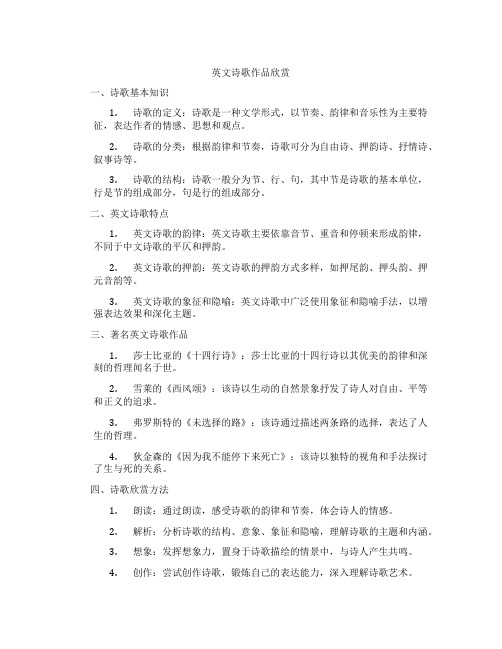
英文诗歌作品欣赏一、诗歌基本知识1.诗歌的定义:诗歌是一种文学形式,以节奏、韵律和音乐性为主要特征,表达作者的情感、思想和观点。
2.诗歌的分类:根据韵律和节奏,诗歌可分为自由诗、押韵诗、抒情诗、叙事诗等。
3.诗歌的结构:诗歌一般分为节、行、句,其中节是诗歌的基本单位,行是节的组成部分,句是行的组成部分。
二、英文诗歌特点1.英文诗歌的韵律:英文诗歌主要依靠音节、重音和停顿来形成韵律,不同于中文诗歌的平仄和押韵。
2.英文诗歌的押韵:英文诗歌的押韵方式多样,如押尾韵、押头韵、押元音韵等。
3.英文诗歌的象征和隐喻:英文诗歌中广泛使用象征和隐喻手法,以增强表达效果和深化主题。
三、著名英文诗歌作品1.莎士比亚的《十四行诗》:莎士比亚的十四行诗以其优美的韵律和深刻的哲理闻名于世。
2.雪莱的《西风颂》:该诗以生动的自然景象抒发了诗人对自由、平等和正义的追求。
3.弗罗斯特的《未选择的路》:该诗通过描述两条路的选择,表达了人生的哲理。
4.狄金森的《因为我不能停下来死亡》:该诗以独特的视角和手法探讨了生与死的关系。
四、诗歌欣赏方法1.朗读:通过朗读,感受诗歌的韵律和节奏,体会诗人的情感。
2.解析:分析诗歌的结构、意象、象征和隐喻,理解诗歌的主题和内涵。
3.想象:发挥想象力,置身于诗歌描绘的情景中,与诗人产生共鸣。
4.创作:尝试创作诗歌,锻炼自己的表达能力,深入理解诗歌艺术。
五、诗歌在中小学教育中的重要性1.培养审美能力:诗歌欣赏有助于提高学生的审美情趣和审美能力。
2.提高语言素养:通过学习诗歌,学生可以提高词汇量、增强语言表达能力。
3.陶冶情操:诗歌中的美和哲理有助于培养学生高尚的情操和健康的人格。
4.传承文化:诗歌是民族文化的重要组成部分,学习诗歌有助于传承和弘扬文化。
英文诗歌作品欣赏是一种富有韵律美和哲理性的文学艺术。
通过学习诗歌,学生可以提高语言素养、培养审美能力和陶冶情操,同时深入了解民族文化。
在我国中小学教育中,诗歌教育具有重要意义,应大力推广和普及。
经典英文诗歌鉴赏范文
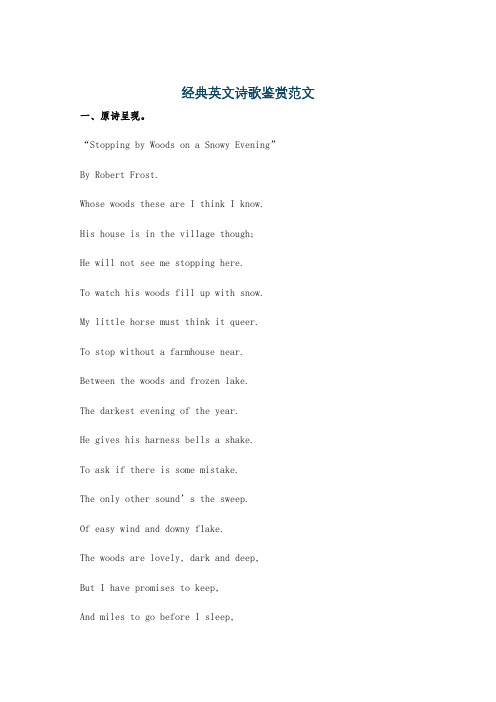
2024年上海初三物理一模汇编:动态电路1、(2024崇明一模)“热敏电阻”控制型动态电路如图1所示的电路,电源电压不变,R 1为热敏电阻,其阻值随温度的升高而减小.闭合开关S ,当监控区的温度升高时,电流表和电压表示数变化的情况是A .电流表示数变大,电压表示数变大B .电流表示数变小,电压表示数变小C .电流表示数变大,电压表示数变小D .电流表示数变小,电压表示数变大2、(2024徐汇一模)图6为烟雾报警器的模拟电路, R 1是滑动变阻器,R c 是气敏电阻,其阻值会随烟雾浓度增大而减小。
当烟雾浓度C 达到8%,电压表示数小于U 0时就会报警。
若要增大该装置对烟雾探测的灵敏度,即烟雾浓度C 达到4%时就报警,下列方案中可行的是 A .增大电源电压 B .向右移动滑片PC .增大电源电压,向右移动滑片PD .减小电源电压,向右移动滑片P3、(2024长宁一模)在图1所示的电路中,电源电压保持不变,电阻R 1、R 2均为定值电阻。
若在电路中添加一个电压表,闭合开关S 前后,发现电压表与电流表示数的比值不变,则电压表并联的位置 A .只能是MN 两点间 B .可能是PN 两点间 C .只能是MQ 两点间 D .可能是PM 两点间4、(2024黄浦一模)在图2所示的电路中,闭合开关S ,电路正常工作。
现对电路分别进行下列操作:①将滑动变阻器滑片向左移;②用电阻R 3(R 3>R 1)替换电阻R 1;③断开开关S ;④增大电源电压。
其中能使电压表示数变大的操作有 A .1个 B .2个 C .3个D .4个图1R 1 R 2VAS监控区 R 1S图6R C V P SR 1 R 2A图1NPMQ图2 VSR 1R 2P5、(2024宝山一模)如图7所示电路,滑动变阻器R 2的滑片P 向右移动时,判断电表的示数变化情况。
小宝同学的分析如下:①滑动变阻器的阻值变大→②电路的总电阻变大→③电流表A 的示数变小→④电压表V 的示数变大。
sweet and low 诗歌
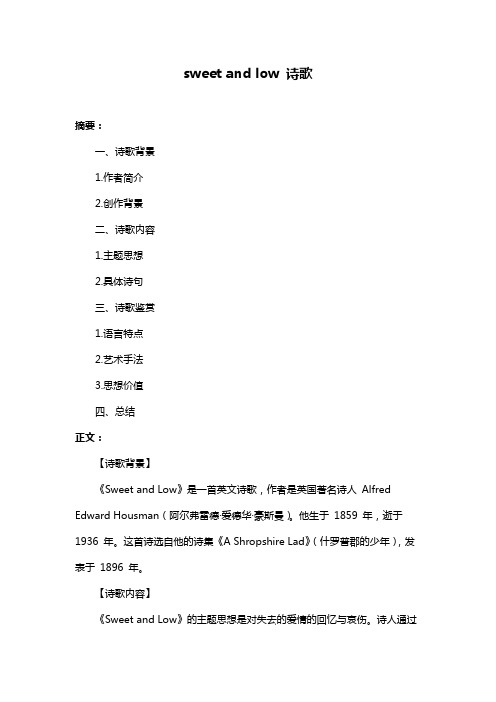
sweet and low 诗歌摘要:一、诗歌背景1.作者简介2.创作背景二、诗歌内容1.主题思想2.具体诗句三、诗歌鉴赏1.语言特点2.艺术手法3.思想价值四、总结正文:【诗歌背景】《Sweet and Low》是一首英文诗歌,作者是英国著名诗人Alfred Edward Housman(阿尔弗雷德·爱德华·豪斯曼)。
他生于1859 年,逝于1936 年。
这首诗选自他的诗集《A Shropshire Lad》(什罗普郡的少年),发表于1896 年。
【诗歌内容】《Sweet and Low》的主题思想是对失去的爱情的回忆与哀伤。
诗人通过描绘自然景象,抒发内心深藏的感情。
具体诗句如下:"Sweet and Low"When the night is spread against the sky,And the stars are out to shine and die,Sweet and Low, sweet and low,Wind of the Western Sea,Blow up the window, let me fly,For the love I bear,Sweet and Low, sweet and low.【诗歌鉴赏】1.语言特点:诗人运用了优美的韵律和生动的比喻,如“夜幕降临”,“繁星闪耀”,表达了诗歌的主题。
同时,通过“窗”的意象,将自然景象与内心情感紧密联系,为读者呈现一幅美丽的画面。
2.艺术手法:诗人运用了象征和拟人手法,将“风”拟人化为“Wind of the Western Sea”,寓意着诗人渴望逃离现实,回到过去那段美好的时光。
同时,用“Sweet and Low”这一标题,既指代了诗歌中的旋律,也象征了诗人心中的美好回忆和无尽的忧伤。
3.思想价值:通过这首诗,我们可以感受到诗人对失去的爱情的深深眷恋和无尽的思念。
这种情感是普世的,让读者产生共鸣。
- 1、下载文档前请自行甄别文档内容的完整性,平台不提供额外的编辑、内容补充、找答案等附加服务。
- 2、"仅部分预览"的文档,不可在线预览部分如存在完整性等问题,可反馈申请退款(可完整预览的文档不适用该条件!)。
- 3、如文档侵犯您的权益,请联系客服反馈,我们会尽快为您处理(人工客服工作时间:9:00-18:30)。
简评:
蚂蚁一向被誉为“勤做工”的典范。此诗更是一一列举这位“模范工人”的美德:工作能力强,多做不抱怨,犯难不求赏,与“人”不计较,见利不思迁。这种工人真是只应“地下”有,“人”世间难求。无怪乎说话者要扼腕叹道:“只可惜他不为我工作。” 作者借蚂蚁而反衬出人类的私心。工整的韵脚添增了全诗的幽默轻松气氛。
Nor does he frown or look askance
At other, lighter-burdened ants.
Not one to bicker, blame, or sob.
The ant has but one flaw I see,
To wit, he doesn't work for me.
But I have promises to keep,
And miles to go before I sleep,
And miles to go before I sleep.
2. 头韵:是指一行(节)诗中几个词开头的辅音相同,形成押韵。下例中运用/f/、/b/与/s/头韵生动写出了船在海上轻快航行的景象。
And like a thunderbolt he falls.
这短短六行,生动地刻划出鹰之为王者的特质。
首节三行写其静、高孤而尊贵。作者以he、hands、stands分别取代it、claws(爪)、和perches(栖息),拟人(personification)的用法使读者感到鹰的非比寻常。更何况它像王者一般独居(in lonely lands),有青天环绕(Ringed with the azure world),与白日相亲(Close to the sun)。首行/k/和/kr/的双声铿锵地暗示出鹰的遒劲。
Till a` / the seas / gang dry:
注: art=are thou=you luve=love thee[thou的宾格] bonnie=beautifl a`=all gang=go
上例中为四音步与三音步交叉。
2.扬抑格(重轻格)Trochee:每个音步由一个重读音节加一个非重读音节构成。
英诗浩如烟海,篇幅长短不一。为使大家了解英诗,并能欣赏,请大家学习以下四个方面的内容:诗的格律、诗的押韵、诗的体式、诗的评判。
一、 诗的格律
格律是是每个音步轻重音节排列的格式,也是朗读时轻重音的依据。而音步是由重读音节和非重读音节构成的诗的分析单位。重读音节为扬(重),非重读音节为抑(轻),音步之间可用“/”隔开。以下是五种常见格式:
It fell to earth, I knew not where;
For, so swiftly it flew, the sight
Could not follow it in its flight.
2) 交叉韵:abab型。
Sunset and evening star,
Sonnet 60
Like as the waves make towards the pibbled shore,
So do our minutes hasten to their end;
Each changing place with that which goes before,
在同一首诗中常会出现不同的格律,格律解析对朗读诗歌有一定参考价值。现代诗中常不遵守规范的格律。
二、 诗的押韵
押韵是指通过重复元音或辅音以达到一定音韵效果的诗歌写作手法。
1. 尾韵:最常见,最重要的押韵方式。
1) 联韵:aabb型。
I shot an arrow into the air,
ˊTouch her not / scornfully,
ˊThink of her / mournfully.
5. 抑扬抑格(轻重轻格)Amphibrach:每个音步由一个非重读音节加一个重读音节再加一个非重读音节构成。如:三音步抑扬抑格︶
下例中双音步为抑扬格。
O hush thee / my baby / thy sire was / a knight.
后三行写其动。作者仍旧以周围环境衬托出鹰的威仪。从高踞山墙之内的鹰眼看来,汹涌的波涛不过是皱纹,在它脚下匍匐。闪电般的俯冲既是写实,也显示出鹰的「神」威-古代神只以雷电为刑罚工具。
这首短诗的三、六两行各以掉尾句(periodic sentence)结束。予人雄浑、踏实的感觉,十分切合诗中所述鹰的王者身份。
Because it's after working hours.
Though underground, he bears the onus
And peril without thought of bonus,
And never once is heard to mention
Retiring on a tax-free pension.
下面一节诗中/i/及/iη/重复照应,呈现出一派欢乐祥和的气氛。
Spring, the sweet spring, is the year’s pleasant king;
Then blooms each thing, then maids dance in a ring,
Cold doth not sting, the pretty birds do sing:
Cuckoo, jug-jug, pu-we, to-witta-woo!
三、 诗的体式
有的诗分成几节(stanza),每节由若干诗行组成(每行诗均以大写字母开头);有的诗则不分节。目前我们常见的诗体有:
1. 十四行诗 (Sonnet),源于中世纪民间抒情短诗,十三、十四世纪流行于意大利,意大利彼特拉克(Petrarch)为代表人物,每行十一个音节,全诗一节八行,加一节六行,韵脚用abba, abba, cdcdcd (cdecde)。前八行提问,后六行回答。
下例中为四音步扬抑格(少一个轻音节)。
Tiger!/ Tiger!/ burning / bright
In the / forests / of the / night
3. 抑抑扬格(轻轻重格)Anapaestic foot: 每个音步由两个非重读音节加一个重读音节构成。如:三音步抑抑扬格
And time that gave doth now his gift confound.
Time doth transfix the flourish set on youth
And delves the parallels in beauty's brow,
Feeds on the rarities but for his scythe to move.
后来,怀亚特(Thomas Wyatt,1503-1542)将十四行诗引人英国,五音步抑扬格,全诗三个四行一个二行,前三节提问,后二句结论。
斯宾塞(Edmund Spenser,1552-1599)用韵脚 abab, bcbc,cdcd,ee。莎士比亚(William Shakespeare,1564-1616)用韵脚abab,cdcd,dfdf,gg,称英国式或莎士比亚式。
为什么造物主让我醒了吗?
他一定要我的碎屑,其发光
一年的转
琼Houlihan由
这是遗憾:或雪貂。抽,
受尽下雪的猪。
一天之后慢慢吞吞下来
悔改的匆匆和群体的,
受害者是一个不稳定的出生。
低头。看着巢穴。
在新生东侧的火花和罢工了
我必使我的平安、低灯泡
Close to the sun in lonely lands,
Ringed with the azure world, he stands.
The wrinkled sea beneath him crawls;
He watches from his mountain walls,
英文诗歌赏析
摘自 中学英语教学资源网
Appreciation of English Poetry
诗以高度凝结的语言表达着人们的喜怒哀乐,用其特有的节奏与方式影响着人们的精神世界。诗讲究联想,运用象征、比喻、拟人等各种修辞手法,形成了独特的语言艺术。
关闭了一年
由Joan霍利汉
这是遗憾:或雪貂。 Snuffling,
发育迟缓,一吻雪爆满。
由于结束了一天的洗牌
疾走的忏悔和群,
一个不稳定的痛悔出生。
弯腰。看看巢穴。
凡新生儿虔诚火花和罢工
我必使我的平安低灯泡
燃烧成雪凹痕。让我一个布
从渗出。光揉皱了一个洞。
The fair breeze blew, the white foam flew,
The furrow followed free,
We were the first that ever burst
Into that silent sea.
3.内韵(同元音):指词与词之间元音的重复形成的内部押韵。
In sequent toil all forwards do contend,
Nativity, once in the main of light,
Crawls to maturity, wherewith being crowned,
Crooked eclipses against his glory fight,
And one clear call for me!
And may there be no moaning of the bar,
When I put out to sea,
